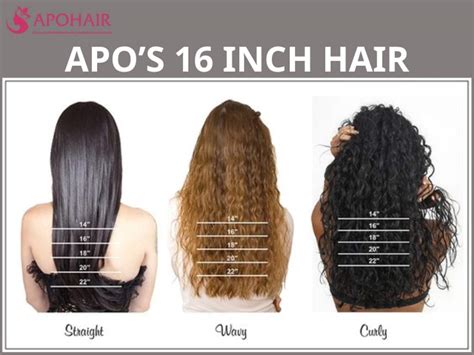Introduction
16 inches of hair is a versatile length that offers endless styling possibilities, from chic bobs to flowing locks. Whether you’re looking to switch up your look or achieve your hair goals, 16 inches is an ideal starting point.

Determining If 16 Inches is Right for You
The ideal hair length varies based on individual preferences, face shape, and hair texture. Here’s a general guide:
- Oval Face Shape: Suited for most lengths, including 16 inches.
- Round Face Shape: May benefit from longer lengths, such as 16 inches, to create an elongated effect.
- Square Face Shape: Shorter lengths around the chin, such as a 16-inch bob, can soften strong angles.
- Thin Hair Texture: 16 inches can enhance volume and body, especially with layers and texture.
- Thick Hair Texture: 16 inches may become too heavy and difficult to manage.
Styling 16 Inches Hair
Hairstyles for 16 Inches Hair
- Long Layers: Add volume and movement, flattering for all face shapes.
- Blunt Bob: Chic and timeless, framing the face and accentuating the cheekbones.
- Mid-Length Shag: Edgy and carefree, with short, layered sections and plenty of texture.
- Fishtail Braid: A romantic and ethereal style that showcases the length of the hair.
- Messy Bun: Effortlessly chic and versatile, can be dressed up or down.
Maintaining 16 Inches Hair
- Regular Trims: Trim split ends every 8-12 weeks to prevent breakage and keep hair healthy.
- Moisturizing: Use hydrating conditioners and hair masks to prevent dryness and maintain shine.
- Heat Protection: Always apply a heat protectant spray before using heat styling tools to minimize damage.
- Minimal Brushing: Avoid over-brushing, which can cause breakage. Use a wide-toothed comb instead.
- Protective Hairstyles: Wear your hair in braids or buns when sleeping or exercising to prevent tangles.
Pros and Cons of 16 Inches Hair
Pros:
- Versatility: Can be styled in a wide range of haircuts and styles.
- Length: Long enough for braids, ponytails, and updos.
- Flattering: Suited for most face shapes and hair textures.
Cons:
- Maintenance: Requires regular trims and more frequent styling.
- Weight: Can become heavy and difficult to manage, especially for thick hair.
- Split Ends: More prone to breakage if not properly cared for.
Common Mistakes to Avoid
- Over-Styling: Using too much heat or chemical treatments can damage the hair.
- Neglecting Trims: Split ends can travel up the hair shaft, causing further breakage.
- Not Using Heat Protectant: Can lead to dry, brittle hair.
- Over-Brushing: Can cause tangles and breakage.
- Sleeping with Wet Hair: Can lead to breakage and tangles.
Innovative Applications: “Glossamizing”
A new hair care technique, “glossamizing,” involves using a combination of hair glosses, masks, and treatments to enhance hair color, add shine, and reduce porosity. This technique can be particularly beneficial for 16-inch hair, creating a lustrous and healthy appearance.
Tables
| Feature | Measurement |
|---|---|
| Hair Length | 16 inches |
| Ideal Face Shapes | Oval, Round, Square |
| Suitable for Thin Hair | Yes |
| Suitable for Thick Hair | May be heavy |
| Styling Versatility | High |
| Maintenance Level | Moderate |
| Hairstyles for 16 Inches Hair | Description |
|---|---|
| Long Layers | Adds volume and movement |
| Blunt Bob | Chic and timeless |
| Mid-Length Shag | Edgy and carefree |
| Fishtail Braid | Romantic and ethereal |
| Messy Bun | Effortlessly chic and versatile |
| Maintenance Tips for 16 Inches Hair | Frequency |
|---|---|
| Trims | 8-12 weeks |
| Moisturizing | Weekly |
| Heat Protection | Before using heat |
| Minimal Brushing | Daily |
| Protective Hairstyles | When sleeping or exercising |
| Pros and Cons of 16 Inches Hair | |
|---|---|
| Pros | Cons |
| Versatility | Maintenance |
| Length | Weight |
| Flattering | Split Ends |
Conclusion
16 inches of hair is a versatile and stylish length that can be customized to suit individual needs and preferences. By understanding the styling and maintenance requirements, you can enjoy the beauty and confidence that comes with rocking 16-inch locks.
